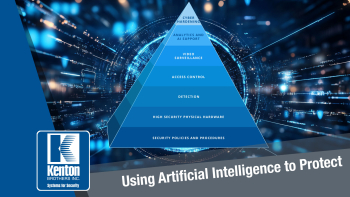Top 10 ways Kenton Brothers is using AI to protect people, property and possessions.
By Gina Stuelke, CEO of Kenton Brothers
 In line with our core values of continuous learning, innovation and customer focus, as a physical security integrator, Kenton Brothers is increasingly leveraging AI technology to enhance security operations, improve efficiency, and deliver advanced solutions to our clients.
In line with our core values of continuous learning, innovation and customer focus, as a physical security integrator, Kenton Brothers is increasingly leveraging AI technology to enhance security operations, improve efficiency, and deliver advanced solutions to our clients.
Here’s how we’re putting AI to work:
1) AI-Powered Video Surveillance
- Intelligent Video Analytics: AI algorithms can analyze video feeds in real-time to detect suspicious behaviors, unauthorized access, or potential threats. For example, AI can identify intruders, recognize objects (such as weapons), and track movements.
- Facial Recognition: AI enables automated identification of individuals based on facial features, allowing for efficient access control and security checks.
- Behavioral Analysis: AI can detect abnormal behaviors, such as loitering, aggressive movements, or unauthorized gatherings, alerting security personnel to potential risks.
2) Predictive Maintenance and Monitoring
- Proactive System Maintenance: AI-driven analytics help predict when security equipment (such as cameras or alarms) might fail, enabling integrators to schedule maintenance before malfunctions occur. This reduces downtime and enhances system reliability.
- Monitoring IoT Devices: AI helps manage and monitor IoT-connected security systems, ensuring these devices remain secure and functional.
3) Access Control and Authentication
- Biometric Authentication: AI is used for facial recognition, fingerprint scanning, and iris detection, ensuring only authorized personnel can access secured areas. AI enhances accuracy by learning and improving identification over time.
- Behavioral Biometrics: AI systems can analyze users’ behavioral patterns (such as typing speed or gait) to authenticate users dynamically, adding another layer of security beyond traditional credentials.
4) Cybersecurity and Threat Detection
- AI for Intrusion Detection: AI helps monitor digital networks tied to physical security systems, identifying potential cyber threats such as hacking attempts or malware. Physical security integrators use AI to strengthen the digital defenses of connected security devices, preventing breaches.
- Anomaly Detection: AI can flag abnormal behaviors in security networks, such as unexpected traffic patterns or unauthorized access attempts, allowing integrators to address cybersecurity vulnerabilities before they lead to physical security breaches.
5) Automation of Security Tasks
- Automated Monitoring and Reporting: AI automates routine security tasks like monitoring large-scale environments or compiling daily security reports. This allows human operators to focus on more complex tasks.
- Drones and Robotics: AI-powered drones and robots are being deployed to patrol large areas autonomously, monitoring for security risks, and reporting anomalies back to a central system.
6) Improved Incident Response
- AI-Powered Threat Response: When AI detects a security breach or potential risk, it can trigger automated responses like locking doors, alerting security personnel, or deploying drones. AI systems can prioritize incidents based on severity, ensuring that the most urgent issues are addressed first.
- Integrated Security Systems: AI helps integrate various security systems (video surveillance, access control, alarms) into one platform, providing a holistic view of security events and streamlining incident response.
7) Data-Driven Insights
- Enhanced Decision-Making: AI helps physical security integrators analyze vast amounts of data from multiple sources (cameras, sensors, access logs) to provide actionable insights. This can include identifying vulnerabilities, optimizing security layouts, or predicting future threats.
- Heat Mapping: AI can create heat maps of physical spaces based on foot traffic patterns. Clients can use these insights to improve security placement and better understand how spaces are being used.
8) Real-Time Alerts and Notifications
- Smart Alerts: AI systems can provide real-time notifications to security teams based on detected risks or rule violations. Alerts are more precise, reducing false positives and allowing security teams to respond quickly and efficiently.
9) AI-Driven Command Centers
- Centralized Management with AI: AI is used to streamline the operations of command centers where multiple security feeds are monitored. AI processes data and can escalate incidents automatically, helping integrators improve response times.
- Virtual Assistants for Command Centers: AI chatbots or virtual assistants can help operators by providing quick access to relevant information, issuing commands, or managing routine tasks like activating or deactivating systems.
10) Cost Efficiency and Scalability
- Optimized Resource Allocation: AI allows integrators to optimize the placement and use of security personnel. For example, it can flag areas of concern, allowing security officers to focus on specific zones rather than patrolling areas that don’t need attention.
- Scalability: AI-driven systems are more scalable than traditional security setups. As security needs grow, AI can manage and analyze larger datasets without a proportional increase in manpower, making security operations more cost-efficient.
Artificial Intelligence is transforming physical security by automating and enhancing traditional security processes, improving threat detection, and enabling smarter, more proactive security solutions. Kenton Brothers is able to offer more advanced and efficient systems that better protect assets and people while reducing costs and human labor.
If you are ready to take advantage of all that AI is bringing to commercial security, please give us a call. Let’s work together to create solutions to your security concerns!




Leave a Reply
Want to join the discussion?Feel free to contribute!